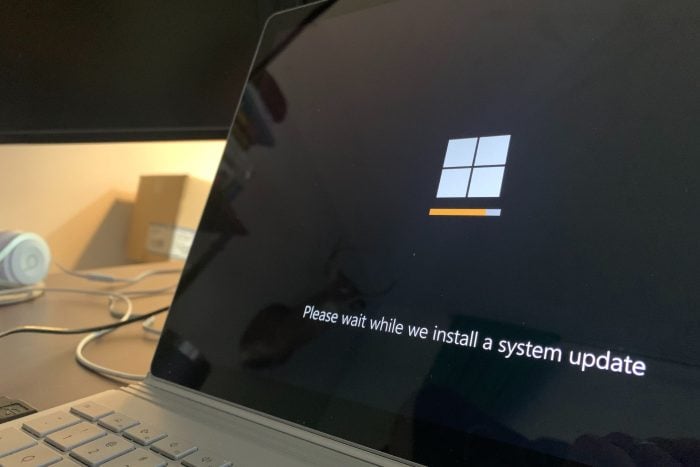Microsoft released KB5037002 to the Windows 11 Beta Channel and it comes with dozens of huge fixes
KB5037002 is now available to the Windows 11 Beta insiders.
4 min. read
Published on
Read our disclosure page to find out how can you help Windows Report sustain the editorial team Read more

It’s that part of the week when Microsoft releases its usual Insider patches to the Windows Insider Program, and this time the Redmond-based tech giant has chosen to update the Beta Insider Channel with the KB5037002 patch.
This time, the KB5037002 patch comes with dozens of huge fixes. For instance, the Show Desktop button is returning to Windows 11’s taskbar, and the very useful drag-and-drop capability in File Explorer that debuted in the other channels of the Windows 11 Insider Program, is now available to Beta users.
However, the KB5037002 patch will be fixing a lot of annoying bugs in Windows 11, as you can see below:
- New! This update improves the Widgets icons on the taskbar. They are no longer pixelated or fuzzy. This update also starts the rollout of a larger set of animated icons.
- New! This update affects Widgets on the lock screen. They are more reliable and have improved quality. This update also supports more visuals and a more customized experience for you.
- This update fixes an issue which was causing Settings to crash when copying out text in the last few flights.
- This update addresses an issue that affects universal printers. The system creates duplicate print queues for them.
- This update adds support for Arm64 .msi files using a Group Policy Object (GPO). You can now use the Group Policy Management Console (GPMC) to add Arm64 .msi files. You can also use a GPO to install these files on Arm64 machines.
- This update affects hypervisor-protected code integrity (HVCI). It accepts drivers that are now compatible.
- This update addresses an issue that occurs when you elevate from a normal user to an Administrator to run an application. When you use a PIN to sign in, the app will not run.
- This update affects Windows Subsystem for Linux 2 (WSL2). Intermittent name resolution fails in a split DNS setup.
- This update addresses an issue that affects the netstat -c It fails to perform effective port exhaustion troubleshooting.
- This update addresses an issue that affects a low latency network. The speed of data on the network degrades significantly. This occurs when you turn on timestamps for a Transmission Control Protocol (TCP) connection.
- This update addresses an issue that affects the Distributed Transaction Coordinator (DTC). A memory leak occurs when it retrieves mappings.
- This update includes quarterly changes to the Windows Kernel Vulnerable Driver Blocklist file, p7b. It adds to the list of drivers that are at risk for Bring Your Own Vulnerable Driver (BYOVD) attacks.
- This update affects the touch keyboard. It makes the Japanese 106 keyboard layout appear as expected when you sign in.
- This update adds a new mobile device management (MDM) policy called “AllowScreenRecorder.” It affects the Snipping Tool. IT admins can use this policy to turn off screen recording in the app.
- This update addresses an issue that affects Bluetooth Advanced Audio Distribution Profile (A2DP) hardware offload. A stop error occurs on PCs that support it.
- This update addresses a memory allocation issue in the Host Networking Service (HNS). The issue causes high memory consumption. It also affects service and pod deployment and scaling.
- This update addresses an issue that affects the container networking Address Resolution Protocol (ARP). It returns the wrong Virtual Subnet ID (VSID) for external ports.
- This update affects media allocations. It improves their memory granularity for some hardware setups. This lowers overcommitment. Also, performance is more efficient.
- This update addresses an issue that affects an accelerator backing store management path. A memory leak occurs that affects some devices.
- This update addresses an issue that affects Windows Local Administrator Password Solution (LAPS). Its Post Authentication Actions (PAA) do not occur at the end of the grace period. Instead, they occur at restart.
- This update addresses a race condition that might stop a machine from starting up. This occurs when you set up a bootloader to start up multiple OSes.
- This update makes Country and Operator Settings Asset (COSA) profiles up to date for some mobile operators.
- This update addresses an issue that affects the Resilient File System (ReFS). A high load might make the system unresponsive. Also, signing in might be slow.
- This update addresses an issue that affects Settings. It stops responding when you dismiss a flyout menu.
- This update addresses an issue that affects Protected Process Light (PPL) protections. You can bypass them.
You can check the full KB5037002 changelog here.








